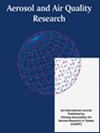A Hybrid Particle Swarm Optimization-Tuning Algorithm for the Prediction of Nanoparticle Morphology from Microscopic Images
IF 2.5
4区 环境科学与生态学
Q3 ENVIRONMENTAL SCIENCES
引用次数: 1
Abstract
Aggregated nanoparticle structures are quite ubiquitous in aerosol and colloidal science, specifically in nanoparticle synthesis systems such as combustion processes where coagulation results in the formation of fractal-like structures. In addition to their size, morphology of the particles also plays a key role in defining various physicochemical properties. Electron microscopy based images are the most commonly used tools in visualizing these aggregates, and prediction of the 3-dimensional structures from the microscopic images is quite complex. Typically, 2-dimensional features from the images are compared to available structures in a database or regression equations are used to predict 3-dimensional morphological parameters including fractal dimension and pre-exponential factor. In this study, we propose a combination of evolutionary algorithm and forward tuning model to predict the best fit 3-dimensional structures of aggregates from their projection images. 2-dimensional features from a projection image are compared to the candidate projections generated using FracVAL code and optimized using Particle Swarm Optimization to obtain the 3-dimensional structure of the aggregate. Various 3-dimensional properties including hydrodynamic diameter and mobility diameter of the retrieved structures are then compared with the properties of the aggregate used to form the candidate projection image, to test the suitability of the algorithm. Results show that the hybrid algorithm can closely predict the 3-dimensional structures from the projection images with less than 10% difference in the predicted 3-dimensional properties including mobility diameter and radius of gyration.基于混合粒子群优化-调谐算法的微观图像纳米粒子形态预测
聚集的纳米颗粒结构在气溶胶和胶体科学中非常普遍,特别是在纳米颗粒合成系统中,如燃烧过程中,混凝导致分形结构的形成。除了它们的大小,颗粒的形态在定义各种物理化学性质方面也起着关键作用。基于电子显微镜的图像是可视化这些聚集体最常用的工具,从显微镜图像中预测三维结构是相当复杂的。通常,将图像中的二维特征与数据库中的可用结构进行比较,或者使用回归方程来预测三维形态参数,包括分形维数和指数前因子。在这项研究中,我们提出了一种进化算法和前向调整模型相结合的方法,从聚集体的投影图像中预测最适合的三维结构。将投影图像中的二维特征与使用分形代码生成的候选投影进行比较,并使用粒子群优化方法进行优化,以获得聚集体的三维结构。然后将检索到的结构的各种三维特性(包括水动力直径和迁移直径)与用于形成候选投影图像的聚集体的特性进行比较,以测试算法的适用性。结果表明,混合算法能较好地预测三维结构,预测的三维特性(包括迁移率、直径和旋转半径)差异小于10%。
本文章由计算机程序翻译,如有差异,请以英文原文为准。
求助全文
约1分钟内获得全文
求助全文
来源期刊

Aerosol and Air Quality Research
ENVIRONMENTAL SCIENCES-
CiteScore
8.30
自引率
10.00%
发文量
163
审稿时长
3 months
期刊介绍:
The international journal of Aerosol and Air Quality Research (AAQR) covers all aspects of aerosol science and technology, atmospheric science and air quality related issues. It encompasses a multi-disciplinary field, including:
- Aerosol, air quality, atmospheric chemistry and global change;
- Air toxics (hazardous air pollutants (HAPs), persistent organic pollutants (POPs)) - Sources, control, transport and fate, human exposure;
- Nanoparticle and nanotechnology;
- Sources, combustion, thermal decomposition, emission, properties, behavior, formation, transport, deposition, measurement and analysis;
- Effects on the environments;
- Air quality and human health;
- Bioaerosols;
- Indoor air quality;
- Energy and air pollution;
- Pollution control technologies;
- Invention and improvement of sampling instruments and technologies;
- Optical/radiative properties and remote sensing;
- Carbon dioxide emission, capture, storage and utilization; novel methods for the reduction of carbon dioxide emission;
- Other topics related to aerosol and air quality.
 求助内容:
求助内容: 应助结果提醒方式:
应助结果提醒方式:


